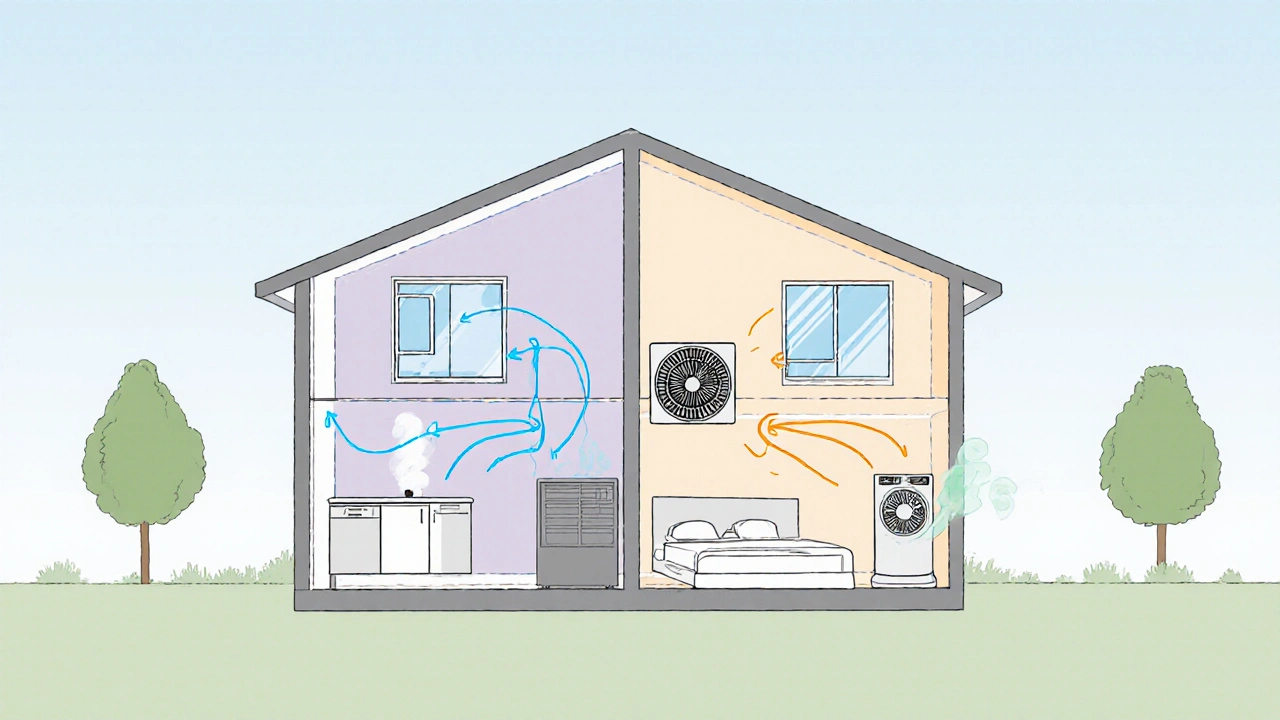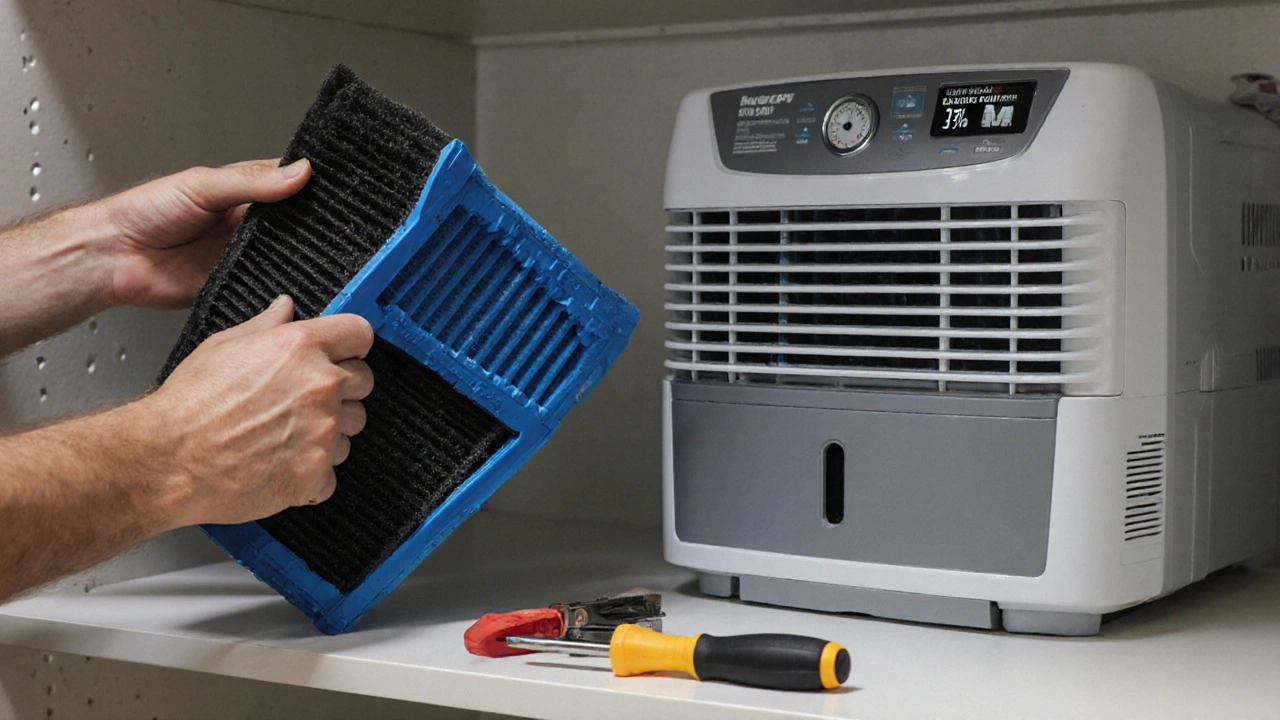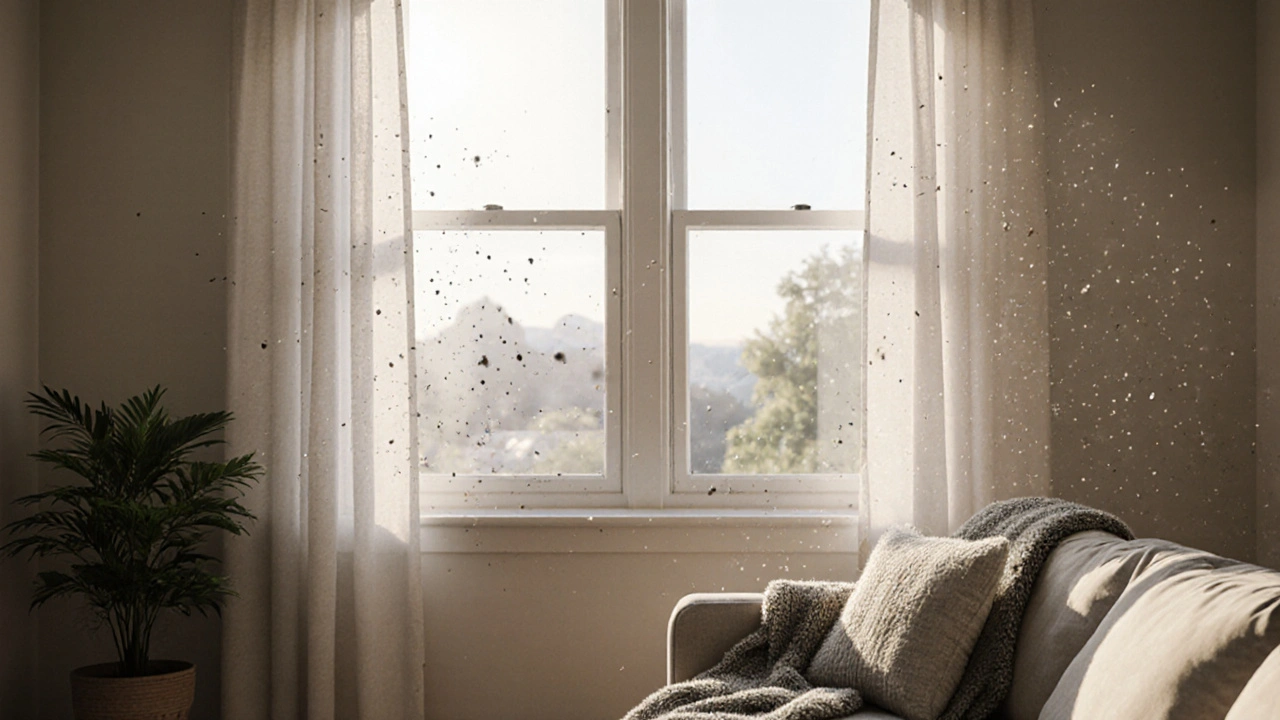Ventilation Strategy Calculator
Recommended Ventilation Strategy
Cross-Ventilation
Natural airflow through open windows. Best for moderate climates and low humidity.
Mechanical Ventilation
HRV/ERV systems provide consistent, controlled air exchange with energy recovery.
Allergy sufferers know the frustration of sneezing, itchy eyes, and congestion that seem to pop up no matter the season. While pollen counts are the usual suspect in spring, indoor allergens can keep symptoms alive throughout the year. The key to year-round allergy relief is proper ventilation. By letting fresh air in and stale air out, you can dramatically lower the concentration of allergens inside your home.
Key Takeaways
- Good ventilation reduces indoor pollen, dust‑mite dust, pet dander, and mold spores.
- Cross‑ventilation, mechanical ventilation, and air‑purification each have strengths and trade‑offs.
- Regular HVAC maintenance and filter upgrades keep the system effective.
- Seasonal adjustments-like using exhaust fans in summer and dehumidifiers in winter-optimize comfort.
- Simple habits such as opening windows for a few minutes each day can make a big difference.
What Is Proper Ventilation?
Proper ventilation is a set of techniques that move outdoor air into a building while exhausting stale indoor air. The goal is to maintain a balanced indoor environment where humidity, temperature, and pollutant levels stay within healthy ranges. When done correctly, ventilation dilutes allergens, removes moisture that fuels mold, and prevents the buildup of volatile organic compounds (VOCs).
How Indoor Air Quality Affects Allergies
Indoor air quality (IAQ) measures the concentration of particles, gases, and biological agents floating in the air inside a home. Poor IAQ can trigger or worsen allergic reactions because tiny particles settle on surfaces, get disturbed by movement, and are inhaled directly into the lungs. Studies from the Australian Asthma Foundation show that households with good IAQ report 30% fewer allergy flare‑ups.

Common Indoor Allergens and How Ventilation Helps
Allergens such as pollen, dust‑mite droppings, pet dander, and mold spores thrive in stagnant, humid air. By regularly exchanging indoor air with fresh outside air, you lower the concentration of each allergen:
- Pollen - Even in winter, pollen can linger on clothing and be re‑released indoors. A few minutes of window opening each morning cuts indoor pollen levels by up to 40%.
- Dust mites - They love humidity above 50%. Ventilation combined with a dehumidifier keeps humidity in the 30‑45% range, reducing mite populations.
- Pet dander - Dander particles stay airborne for hours. Exhaust fans in kitchens and bathrooms help pull these particles out of the living space.
- Mold spores - Stagnant air encourages mold growth on walls and ceilings. Proper airflow dries out surfaces and prevents spore germination.
Ventilation Options - Which One Fits Your Home?
| Method | How It Works | Pros | Cons |
|---|---|---|---|
| Cross‑ventilation (open windows) | Air enters through one opening and exits through another, creating natural airflow. | Low cost, easy to implement, no electricity needed. | Depends on weather, less control over humidity. |
| Mechanical ventilation (ERV/HRV) | Fans exchange indoor and outdoor air while recovering heat or moisture. | Consistent airflow, maintains temperature, good for sealed homes. | Higher upfront cost, requires periodic filter changes. |
| Exhaust fans | Remove stale air from kitchens, bathrooms, or laundry rooms. | Targeted removal of moisture and cooking fumes. | Only works in specific rooms, can increase heating load. |
| Air purifiers with HEPA filter | Recirculate indoor air through a high‑efficiency filter that captures 99.97% of particles ≥0.3µm. | Effective at removing fine allergens, portable. | Does not replace fresh air, needs filter replacement. |
Practical Steps to Optimize Ventilation Year‑Round
- Open windows on opposite sides of the house for 5‑10 minutes each morning. Even on cool days, this quickly lowers indoor pollen.
- Install a heat‑recovery ventilator (HRV) if you live in a tightly sealed home. Set it to run at low speed continuously during allergy season.
- Use bathroom and kitchen exhaust fans while cooking, showering, or cleaning. Keep them on for a few minutes after the activity ends.
- Place a HEPA filter air purifier in the bedroom where you spend the most time.
- Run a dehumidifier in the winter months to keep humidity below 45% and discourage dust‑mite growth.
- Schedule seasonal HVAC check‑ups. Replace filters every 3‑4 months or sooner if you have pets.

Maintenance Tips to Keep Air Clean
HVAC system maintenance is more than cleaning the grill. A well‑maintained system can move air efficiently and filter out allergens before they recirculate.
- Inspect ductwork for leaks. Seal gaps with mastic tape to prevent dust from entering the system.
- Swap to a high‑MERV (Minimum Efficiency Reporting Value) filter-ideally MERV 13-for better particle capture.
- Clean coil fins annually; dirty coils reduce airflow and increase humidity.
A HEPA filter needs replacement every 6‑12 months, depending on usage. Check the manufacturer’s rating for exact intervals.
When humidity spikes above 60%, run a dehumidifier in damp rooms like basements.
When to Call a Professional
If you notice persistent musty odors, water stains on walls, or a sudden increase in allergy symptoms despite using the steps above, it’s time to bring in an HVAC specialist. Professional air‑flow testing can pinpoint hidden leaks or inadequate ventilation rates that DIY fixes miss.
Frequently Asked Questions
How often should I open my windows for effective ventilation?
A short burst of 5‑10 minutes each morning is enough to lower indoor allergen levels dramatically, even in cooler weather. During high pollen days, make it a daily habit.
Can an air purifier replace the need for fresh air?
No. Air purifiers clean the air you already have, but they don’t bring in outdoor oxygen or remove excess humidity. Pair a purifier with proper ventilation for best results.
What humidity level is ideal for reducing dust‑mite allergies?
Keep indoor relative humidity between 30% and 45%. Below 30% it can dry out skin, and above 45% dust mites thrive.
Is a heat‑recovery ventilator worth the investment?
For sealed modern homes, an HRV recovers up to 80% of the heat from outgoing air, saving on heating bills while ensuring constant fresh air. The payback period is usually 3-5 years.
How do I know if my HVAC filter needs changing?
If the filter looks visibly dark, you notice reduced airflow, or you’ve had pets for several months, replace it. A good rule is every 3‑4 months for standard filters, 6‑12 months for HEPA.


Mithun Paul
October 8, 2025 AT 20:54From an analytical perspective, the efficacy of ventilation hinges on controlled air exchange rates and humidity regulation. Empirical studies indicate that cross‑ventilation can reduce indoor pollen concentrations by up to 40 percent when implemented consistently. Mechanical systems such as HRVs, however, provide a deterministic airflow independent of external weather conditions, thereby ensuring a stable indoor environment. The data also reveal that maintaining relative humidity between 30 % and 45 % curtails dust‑mite proliferation, which is a primary allergen source. Consequently, a hybrid approach-employing natural ventilation when feasible and resorting to mechanical assistance during adverse conditions-optimizes allergen mitigation while conserving energy.
Sandy Martin
October 9, 2025 AT 19:07That explanation really ties the pieces together; it’s clear that a balanced strategy works best. I appreciate the precise breakdown of percentages and the distinction between natural and mechanical methods. It helps everyday readers see the practical steps they can take. Even if you’re not a tech‑savvy homeowner, opening windows for a short burst each morning can make a noticeable difference.
Steve Smilie
October 10, 2025 AT 20:07Permit me to indulge in a little lyrical homage to the art of breathing fresh air within our domiciles. Imagine, if you will, a gust of zephyrus slipping through a casement, whisking away pollen particles with the elegance of a prima ballerina. Such cross‑ventilation, while seemingly simple, is a symphony of thermodynamics and atmospheric poetry. Yet, modern sealed abodes demand a more sophisticated partner – the heat‑recovery ventilator, a mechanical virtuoso that recaptures thermal energy with the finesse of a seasoned barista extracting espresso. When these two methods dance in concert, the result is a harmonious reduction of allergens, a veritable lullaby for the immune system. Moreover, the strategic placement of exhaust fans in culinary and lavatory sanctuaries acts as a diligent sentinel, expelling moisture and volatile compounds with unwavering resolve. To the diligent homeowner, I advise the deployment of a high‑efficiency MERV‑13 filter, which, akin to a vigilant gatekeeper, arrests microscopic invaders before they infiltrate the circulation. Humidity, that capricious nemesis, must be tamed; maintain it within the sweet spot of 30‑45 %, lest dust mites revel in the excess. A dehumidifier, operating like a silent butler, can orchestrate this balance during winter’s oppressive chill. For those dwelling in the realm of the hyper‑sealed, an HRV becomes not merely an appliance but a lifeline to the outside air, preserving thermal comfort while delivering fresh breaths. The cumulative effect of these measures is nothing short of a renaissance for respiratory well‑being, a rebirth of the lungs themselves. In closing, remember that the simplicity of a ten‑minute window opening can rival the complexity of any engineered system in its efficacy; sometimes, the most profound solutions are the most unassuming. Let us, therefore, celebrate the humble act of inviting the world’s air into our homes, for it is the ultimate antidote to the invisible tyrants of allergy.
Josie McManus
October 11, 2025 AT 18:21Yo, i cant stress this enough-stop ignoring the basics. Open those windows daily, even if it’s cold, trust me the pollen drop is real. And don’t skimp on the fans in the bathroom; they pull out that dander fast. If your house feels sealed, get an HRV-no brainer for mite control. Keep humidity low, like 40%, otherwise you’re feeding dust mites.
Heather Kennedy
October 12, 2025 AT 13:47Agreed, the integration of HVAC‑based MERV‑13 filtration aligns with industry best practices for particulate reduction. Leveraging exhaust fans as localized contaminant capture devices complements the overall IAQ strategy. Coordinating these subsystems can be described as a multi‑layered defense architecture, which is both scalable and cost‑effective.
Janice Rodrigiez
October 13, 2025 AT 12:01Fresh air beats stale air every time.
Roger Cardoso
October 14, 2025 AT 13:01What they don’t tell you is that the whole ventilation industry is a front for a covert operation to monitor indoor air quality and feed data back to shadow entities. All those HRVs are equipped with sensors that log your breathing patterns, effectively turning your home into a surveillance hub. The push for “allergy relief” is just a distraction while they harvest personal health data for undisclosed uses.
barry conpoes
October 15, 2025 AT 11:14Patriotically speaking, a strong nation builds strong homes. Installing American‑made HRVs supports our economy and guarantees that the air we breathe is free from foreign interference. Don’t let globalist agendas dictate how you ventilate; trust in home‑grown solutions.
Kristen Holcomb
October 16, 2025 AT 10:51Friends, the key is consistency. Set a reminder on your phone to open windows each morning and check humidity levels weekly. When you see the numbers stay in the 30‑45 range, you’ll notice your sneezes taper off. It’s all about building those healthy habits together.
justin davis
October 17, 2025 AT 09:04Wow!!! Who needs a fancy HRV when you can just swing a window open and pretend you’re on a nature documentary, right???? Spoiler: you still get better air, and it’s free!!!
David Lance Saxon Jr.
October 18, 2025 AT 08:41Consider the epistemological dimensions of indoor airflow: we are not merely exchanging gases, but negotiating with the environment’s latent pathogen vector field. By invoking an HRV, we assert agency over stochastic allergen influx, thereby reifying the home as a controlled micro‑cosm. This praxis aligns with a phenomenological reduction of external irritants, fostering a calibrated sensory experience.
Moore Lauren
October 19, 2025 AT 06:54Keep it up you’ve got this! Small steps like a ten‑minute window open will pay off big time.
Jonathan Seanston
October 20, 2025 AT 07:54Absolutely, let’s cheer each other on-every breath of fresh air is a win for the whole crew.